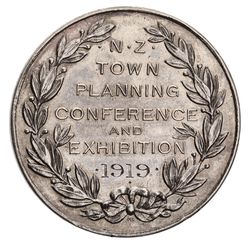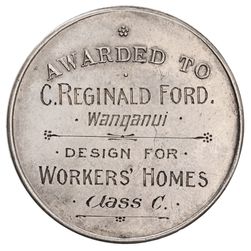Commemorative & Historical Medals 1906-1935
Lot 607 SESSION 2 (11.30AM MONDAY 11TH SEPTEMBER) Commemorative & Historical Medals 1906-1935
Estimate $500
Bid at live.noble.com.au
SOLD $320
N.Z. TOWN PLANNING CONFERENCE AND EXHIBITION, 1919, struck in silver (35mm), no maker, reverse inscribed 'C.Reginald Ford./Wanganui/Design For/Workers' Homes/Class C.' (M.-). Lightly toned, extremely fine and extremely rare.
Ex Leon G.Morel Collection, Mowbray Collectables Sale, November 2004 (lot 389) and unlisted in his catalogue.
Courtesy Peter Lowe. 'Ford, Charles Reginald', from the Dictionary of New Zealand Biography. Te Ara - the Encyclopedia of New Zealand, updated 24-Sep-2013:
Charles Reginald Ford was born in London on 4 February 1880, the son of Charles Matthew Ford, a butler, and his wife, Ellen Catherine McDonald. Little is known of Reginald's early life. It is thought that he joined the Royal Navy from school, and served on several navy vessels. He volunteered to serve on the first of the Royal Geographical Society's National Antarctic Expeditions led by Commander Robert Falcon Scott in the Discovery during 1901-4, serving as steward and as assistant to Scott. The expedition provisioned in Lyttelton before travelling further south. There were periods of real danger, with the Discovery iced in for more than two years, but they returned safely and Ford accompanied Scott on lecture tours around the United Kingdom. He published extracts from his diary of the expedition in 1908.
Ford returned to New Zealand through Canada and Australia about 1906. On 2 September 1908 he married Edith Christine Smith Badger at her parents' home in Christchurch; they were to have two daughters and one son. He was briefly a farmer, and by 1909 was a partner in Ford and Hadfield, land agents. In 1911-12 he produced three pamphlets opposing conscription and compulsory military training.
Reginald Ford began to study architecture in 1906. By 1914 he had moved to Wanganui and established a practice, going into partnership with Robert Talboys in 1919. The bulk of the work consisted of domestic commissions. He was installed as president of the New Zealand Institute of Architects at their annual meeting in Wanganui in 1921. Ford moved to Auckland in 1923 and formed a partnership with W.H.Gummer. In 1924 they submitted an entry for the competition, initiated in 1922, to design the Auckland Civic Centre. Their entry won. They gained considerable professional kudos, but the scheme was rejected in a ratepayers' poll later that year.
Ford and Gummer's practice became one of the most successful in New Zealand between the two world wars. Ford was essentially the business manager and organiser and Gummer the main source of architectural ideas. The practice trained an architect, F.Gordon Wilson, and employed an engineer, John Booth, both of whom later became junior partners. They contributed important extra expertise to the practice, particularly when it undertook some of its bigger and most prestigious commissions, such as the Dominion Museum in Wellington and the Auckland railway station. The two partners shared the first NZIA gold medal ever awarded: in 1928 for the Remuera branch of the Auckland Public Library; they won another in 1931 (with F.Gordon Wilson) for the Auckland railway station. Another important commission was the Dilworth Building in Customs Street. The partnership also carried out work for the New Zealand Insurance Company, the State Fire Insurance Office and the Dingwall Trust. Work on renovating St Benedict's Church resulted in a close and long-term friendship between the Presbyterian Ford and James Liston, the Catholic bishop of Auckland from 1929.
The partnership did much for the education of young architects by providing them with design office experience in a well-run and bustling practice. Ford was also associated with the proposal to appoint a professor of architecture in the school at Auckland University College, which was pursued during his term as president of the NZIA, and he later served on the college's council. He was passionate about professionalism in architecture, and he wrote and lobbied in all avenues open to him to raise its status. Both he and Gummer used their considerable combined persuasive powers to good effect.
Ford made several overseas visits, including one to California in 1922. Possibly as a result of this, he wrote a modest but timely book entitled Earthquakes and building construction (1926), one of the earliest semi-technical works in English to discuss the earthquake hazard to life and buildings. Ford was a keen observer after the Hawke's Bay earthquake of February 1931 and made a photographic record of the devastation. He served on the New Zealand Standards Institute subcommittees dealing with building code revision. He had been a member of the Concrete Institute, London, since 1919 and was made a fellow after it became the Institution of Structural Engineers.
Ford was a fellow of the Royal Geographical Society and served as president of the Auckland Society of Arts. A keen collector of English porcelain, he wrote a guide to the Auckland Institute and Museum's collections of old English pottery and porcelain and was their honorary curator of English china for some years. He had a long association with the Auckland Institute and Museum, sitting on a panel which judged entries in the competition for building the first stage of its war memorial museum, and serving as president.
He disliked some of the fashions of the 1930s and 1940s with which younger architects were experimenting. A cartoon by A. R. D. Fairburn depicts Ford in condescending mood presenting Vernon Brown, one of these young architects, with a spoof award. He and William Gummer retired from their practice in 1961.
Edith Ford died in 1937 and on 10 July 1939 Reginald Ford married Daphne Jessie Dannefaerd at Auckland. There were no children. He died, aged 92, at his St Heliers home on 19 May 1972, survived by his second wife and his three children.
Estimate / sale price does not include buyer's premium (currently 22% including GST) which is added to hammer price. All bids are executed on the understanding that the Terms & Conditions of sale have been read and accepted. For information on grading and estimates please refer to the Buying at Auction advice.
Quick find
View a lot by number and sale.
Adjacent lots
Lot 605
DOVEDALE PEACE CELEBRATIONS, 1919, hand engraved, in silver (23x23mm), no maker, ring top suspension, obverse ...
Estimate $150
Lot 606
OTAUTAU, fob medal, hand engraved in gold (9ct, 6.4g, 27x27mm), no maker, ring top suspension, ...
Estimate $300
Lot 607 This lot
N.Z. TOWN PLANNING CONFERENCE AND EXHIBITION, 1919, struck in silver (35mm), no maker, reverse inscribed ...
Estimate $500
Lot 608
H.M.S. Renown, 1920, uniface, struck in brass (21mm), no maker (M.-). Extremely fine and extremely ...
Estimate $250
Lot 609
H.M.S. Renown, 1920, uniface, struck in brass (21mm), no maker (M.-). Good very fine and ...
Estimate $250

